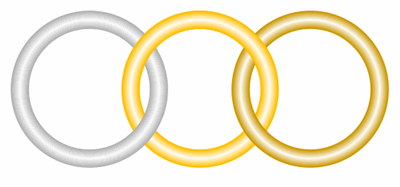
What is Aspect Ratio?
We get frequent emails from customers looking to make a chain from our site using jump rings larger or smaller than those in the instructions. Aspect Ratio is the Ratio (value) between a jump rings wire thickness or gauge (GA) and its Inside Diameter (I.D). Aspect Ratio is sometimes shared by chain maille artists. They take their favorite chain and attempt to make it in different I.D. jump ring sizes until they get, what they consider the perfect chain. Instead of stating that the chain works in 16ga 4.5, they notate the A.R. allowing for the chain to be constructed using different size jump rings. This allows the next artist to build a lighter version using thinner gauge jump rings or a bolder version using thicker gauge jump rings and still maintain the structure of the chain.
The most popular request for aspect ratio is the Byzantine Chain (A.R. 3.5). Here is a quick chart for alternative sizes in jump rings. For those who have a thirst for knowledge, continue down to calculating Aspect Ratio.
Here are 5 formulas for basic byzantine:
22ga (0.6mm) x AR (3.5) = ID 2.1 (22ga 2.0mm ID)
20ga (0.8mm) x AR (3.5) = ID 2.8 (20ga 3.0mm ID)
18ga (1.0mm) x AR (3.5) = ID 3.5 (18ga 3.5mm ID)
16ga (1.3mm) x AR (3.5) = ID 4.5 (16ga 4.5mm ID)
14ga (1.6mm) x AR (3.5) = ID 5.6 (14ga 5.5mm ID)
How to manually calculate the correct jump ring size using A.R.
Let say you see an A.R. in a set of instruction that reads 3.2 A.R.
1. Convert your prefered wire gauge into decimal millimeters. Tons of charts out there, here is a link to one of wikipedia - AWG SWG
Example: 16ga AWG is 1.3mm thick
2. Multiply the A.R value as reported in your instructions and mulitply it by the decimal gauge thickness
Example: AR (3.2) x gauge (1.3) = 4.2mm Inside Diameter
NOTE: Just because you get 4.2 mm ID, don't worry when we don't have that size. There is some leeway, generally I round up to the nearest quarter or half millimeter and try a 4.25mm ID. But I am just as willing to try 4.5mm ID if I think the results will give me a superior outcome.
If you make the chain and you feel it is too heavy, reduce the gauge.
1. Convert your prefered wire gauge into decimal millimeters.
Example: 20ga AWG is 0.8mm thick
2. Multiply the A.R value as reported in your instructions and mulitply it by the decimal gauge thickness
Example: AR (3.2) x gauge (0.8) = 2.6mm Inside Diameter
3. Find a 20ga jump ring with a I.D of 2.6 or greater. Aspect Ratio numbers are not law, some artists prefer a tight weave while others prefer a loose weave and create the A.R. that fits their style.
Note: You cannot calculate AR using gauge values, especially since there is no one wire measurement standard. At thebeadman.com use the A.W.G. American Wire Gauge. Be sure to pay attention between A.W.G and British S.W.G as the values are different.
